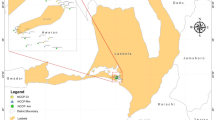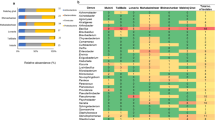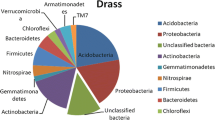Abstract
The present study was conducted to analyze bacterial diversity profile of Cholistan desert located in Pakistan. The study investigates the influence of physicochemical parameters of soil on distribution of different bacteria at all taxonomic levels and also study the distribution pattern between different desert environments, particularly rhizospheric and bulk desert sands. Species richness showed phyla Proteobacteria and Chloroflexi as the dominant OTUs in all the samples. Besides the two phyla, the rhizospheric soils with root remnants were dominated by Firmicutes, Deinococcus-Thermus, Actinobacteria and Acidobacteri, while phylum Thermotogae was present in significant quantity in rhizosheaths devoid of roots. In non-rhizospheric desert soils, a considerable number of OTUs belonged to phyla Proteobacteria, Chloroflexi, Bacteroidetes and Acidobacteria. An important finding from this study is that a bulk portion of the OTUs were assigned to unclassified taxa, indicating a large repertoire of unexplored taxa in the desert ecology of Pakistan. Distribution of taxonomic groups among various regions of the desert was collaborating well with the physicochemical parameters of the sites. The findings of this study establish the fundamental relationships between desert ecosystem, specific native plant and the total bacterial flora. This is the first study of microbial community analysis of any desert in Pakistan and thus, will serve as a future platform to explore further on desert ecosystem functioning by employing the ever-changing biotechnological tools.








Similar content being viewed by others
References
Altschul SF, Gish W, Miller W, Myers EW, Lipman DJ (1990) Basic local alignment search tool. J Mol Biol 215(3):403–410. https://doi.org/10.1016/s0022-2836(05)80360-2
Amin A, Ahmed I, Habib N, Abbas S, Hasan F, Xiao M, Hozzein WN, Li WJ (2016) Microvirga pakistanensis sp. nov., a novel bacterium isolated from desert soil of Cholistan. Pakistan Arch Microbiol 198:933–939. https://doi.org/10.1007/s00203-016-1251-3
Amin A, Ahmed I, Salam N, Kim BY, Singh D, Zhi XY, Xiao M, Li WJ (2017) Diversity and distribution of thermophilic bacteria in hot springs of Pakistan. Microb Ecol 74:116–127. https://doi.org/10.1007/s00248-017-0930-1
An S, Couteau C, Luo F, Neveu J, DuBow MS (2013) Bacterial diversity of surface sand samples from the Gobi and Taklamaken deserts. Microb Ecol 66(4):850–860. https://doi.org/10.1007/s00248-013-0276-2
Andrew DR, Fitak RR, Munguia-Vega A, Racolta A, Martinson VG, Dontsova K (2012) Abiotic factors shape microbial diversity in Sonoran Desert soils. Appl Environ Microbiol 78(21):7527–7537. https://doi.org/10.1128/aem.01459-12
Angers DA, Caron J (1998) Plant-induced changes in soil structure: processes and feedbacks. Biogeochemistry 42(1/2):55–72
Berg G, Smalla K (2009) Plant species and soil type cooperatively shape the structure and function of microbial communities in the rhizosphere. FEMS Microbiol Ecol 68(1):1–13. https://doi.org/10.1111/j.1574-6941.2009.00654.x
Bowker MA, Reed SC, Maestre FT et al (2018) Biocrusts: the living skin of the earth. Plant Soil 429:1–7. https://doi.org/10.1007/s11104-018-3735-1
Buée M, De Boer W, Martin F, van Overbeek L, Jurkevitch E (2009) The rhizosphere zoo: an overview of plant-associated communities of microorganisms, including phages, bacteria, archaea, and fungi, and of some of their structuring factors. Plant Soil 321(1):189–212. https://doi.org/10.1007/s11104-009-9991-3
Campbell BJ, Polson SW, Hanson TE, Mack MC, Schuur EA (2010) The effect of nutrient deposition on bacterial communities in Arctic tundra soil. Environ Microbiol 12(7):1842–1854. https://doi.org/10.1111/j.1462-2920.2010.02189.x
Chu H, Fierer N, Lauber CL, Caporaso JG, Knight R, Grogan P (2010) Soil bacterial diversity in the Arctic is not fundamentally different from that found in other biomes. Environ Microbiol 12(11):2998–3006. https://doi.org/10.1111/j.1462-2920.2010.02277.x
Connon SA, Lester ED, Shafaat HS, Obenhuber DC, Ponce A (2007) Bacterial diversity in hyperarid atacama desert soils. J Geophys Res 112 (G4): n/a–n/a. doi: 10.1029/2006JG000311
Costanza R, d’Arge R, De Groot R, Farber S, Grasso M, Hannon B, Limburg K, Naeem S, O’neill RV, Paruelo J (1997) The value of the world's ecosystem services and natural capital. Nature 387 (6630):253-260
Fierer N, Lennon JT (2011) The generation and maintenance of diversity in microbial communities. Am J Bot 98(3):439–448. https://doi.org/10.3732/ajb.1000498
Garcia-Pichel F, Johnson SL, Youngkin D, Belnap J (2003) Small-scale vertical distribution of bacterial biomass and diversity in biological soil crusts from arid lands in the Colorado plateau. Microb Ecol 46(3):312–321. https://doi.org/10.1007/s00248-003-1004-0
Hamady M, Lozupone C, Knight R (2010) Fast UniFrac: facilitating high-throughput phylogenetic analyses of microbial communities including analysis of pyrosequencing and PhyloChip data. The ISME journal 4(1):17–27. https://doi.org/10.1038/ismej.2009.97
Hamady M, Walker JJ, Harris JK, Gold NJ, Knight R (2008) Error-correcting barcoded primers allow hundreds of samples to be pyrosequenced in multiplex. Nat Methods 5(3):235–237. https://doi.org/10.1038/nmeth.1184
Herman RP, Provencio KR, Herrera-Matos J, Torrez RJ (1995) Resource islands predict the distribution of heterotrophic bacteria in chihuahuan desert soils. Appl Environ Microbiol 61(5):1816–1821
Hur M, Kim Y, Song HR, Kim JM, Choi YI, Yi H (2011) Effect of genetically modified poplars on soil microbial communities during the phytoremediation of waste mine tailings. Appl Environ Microbiol 77(21):7611–7619. https://doi.org/10.1128/aem.06102-11
Kim OS, Cho YJ, Lee K, Yoon SH, Kim M, Na H, Park SC, Jeon YS, Lee JH, Yi H, Won S, Chun J (2012) Introducing EzTaxon-e: a prokaryotic 16S rRNA gene sequence database with phylotypes that represent uncultured species. Int J Syst Evol Microbiol 62(Pt 3):716–721. https://doi.org/10.1099/ijs.0.038075-0
Kuske CR, Ticknor LO, Miller ME, Dunbar JM, Davis JA, Barns SM, Belnap J (2002) Comparison of soil bacterial communities in rhizospheres of three plant species and the interspaces in an arid grassland. Appl Environ Microbiol 68(4):1854–1863
Lauber CL, Hamady M, Knight R, Fierer N (2009) Pyrosequencing-based assessment of soil pH as a predictor of soil bacterial community structure at the continental scale. Appl Environ Microbiol 75(15):5111–5120. https://doi.org/10.1128/aem.00335-09
Li JY, Jin XY, Zhang XC, Chen L, Liu JL, Zhang HM, Jin D (2020) Comparative metagenomics of two distinct biological soil crusts in the tengger desert. China Soil Biol Biochem 140:107637
Lee SH, Jang I, Chae N, Choi T, Kang H (2013) Organic layer serves as a hotspot of microbial activity and abundance in Arctic tundra soils. Microb Ecol 65(2):405–414. https://doi.org/10.1007/s00248-012-0125-8
Li W, Godzik A (2006) Cd-hit: a fast program for clustering and comparing large sets of protein or nucleotide sequences. Bioinformatics (Oxf Engl) 22(13):1658–1659. https://doi.org/10.1093/bioinformatics/btl158
Liu L, Zhu K, Wurzburger N, Zhang J (2020) Relationships between plant diversity and soil microbial diversity vary across taxonomic groups and spatial scales. Ecosphere 11(1):e02999
Loreau M, Naeem S, Inchausti P, Bengtsson J, Grime J, Hector A, Hooper D, Huston M, Raffaelli D, Schmid B (2001) Biodiversity and ecosystem functioning: current knowledge and future challenges. Science 294(5543):804–808
Lu Y, Murase J, Watanabe A, Sugimoto A, Kimura M (2004) Linking microbial community dynamics to rhizosphere carbon flow in a wetland rice soil. FEMS Microbiol Ecol 48(2):179–186. https://doi.org/10.1016/j.femsec.2004.01.004
Mannisto MK, Kurhela E, Tiirola M, Haggblom MM (2013) Acidobacteria dominate the active bacterial communities of Arctic tundra with widely divergent winter-time snow accumulation and soil temperatures. FEMS Microbiol Ecol 84(1):47–59. https://doi.org/10.1111/1574-6941.12035
McCann CM, Wade MJ, Gray ND, Roberts JA, Hubert CR, Graham DW (2016) Microbial communities in a high arctic polar desert landscape. Front Microbiol 7:419. https://doi.org/10.3389/fmicb.2016.00419
McLean E (1982) Soil pH and lime requirement. Methods of soil analysis. Part 2. Chemical and microbiological properties. American Society of Agronomy, Soil Science Society of America, Madison, WI, USA
Nagy ML, Perez A, Garcia-Pichel F (2005) The prokaryotic diversity of biological soil crusts in the Sonoran Desert (Organ Pipe Cactus National Monument, AZ). FEMS Microbiol Ecol 54(2):233–245. https://doi.org/10.1016/j.femsec.2005.03.011
Navarro-Gonzalez R, Rainey FA, Molina P, Bagaley DR, Hollen BJ, de la Rosa J, Small AM, Quinn RC, Grunthaner FJ, Caceres L, Gomez-Silva B, McKay CP (2003) Mars-like soils in the Atacama Desert, Chile, and the dry limit of microbial life. Science 302(5647):1018–1021. https://doi.org/10.1126/science.1089143
Neufeld JD, Mohn WW (2005) Unexpectedly high bacterial diversity in arctic tundra relative to boreal forest soils, revealed by serial analysis of ribosomal sequence tags. Appl Environ Microbiol 71(10):5710–5718. https://doi.org/10.1128/aem.71.10.5710-5718.2005
Nimaichand S, Devi AM, Li W-J (2016) Direct plant growth-promoting ability of actinobacteria in grain legumes. In: Plant growth promoting actinobacteria, Springer, pp 1–16
Orsi WD, Smith JM, Liu S, Liu Z, Sakamoto CM, Wilken S, Poirier C, Richards TA, Keeling PJ, Worden AZ, Santoro AE (2016) Diverse, uncultivated bacteria and archaea underlying the cycling of dissolved protein in the ocean. ISME J 10(9):2158–2173. https://doi.org/10.1038/ismej.2016.20
Parniske M (2005) Plant–fungal associations: cue for the branching connection. Nature 435(7043):750–751
Philippot L, Raaijmakers JM, Lemanceau P, van der Putten WH (2013) Going back to the roots: the microbial ecology of the rhizosphere. Nat Rev Microbiol 11(11):789–799. https://doi.org/10.1038/nrmicro3109
Pointing SB, Belnap J (2012) Microbial colonization and controls in dryland systems. Nat Rev Microbiol 10(8):551–562
Prashar P, Kapoor N, Sachdeva S (2014) Rhizosphere: its structure, bacterial diversity and significance. Rev Environ Sci Biotechnol 13(1):63–77. https://doi.org/10.1007/s11157-013-9317-z
Price MN, Dehal PS, Arkin AP (2010) FastTree 2–approximately maximum-likelihood trees for large alignments. PLoS ONE 5(3):e9490. https://doi.org/10.1371/journal.pone.0009490
Qin S, Li WJ, Dastager SG, Hozzein WN (2016) Editorial: actinobacteria in special and extreme habitats: diversity, function roles, and environmental adaptations. Front Microbiol 7:1415. https://doi.org/10.3389/fmicb.2016.01415
Qu EB, Omelon CR, Oren A, Meslier V, Cowan DA, Maggs-Kölling G, DiRuggiero J (2020) Trophic selective pressures organize the composition of endolithic microbial communities from global deserts. Front Microbiol 10:2952
Rao S, Chan Y, Bugler-Lacap DC, Bhatnagar A, Bhatnagar M, Pointing SB (2016) Microbial diversity in soil, sand dune and rock substrates of the Thar Monsoon Desert. India Indian J Microbiol 56(1):35–45. https://doi.org/10.1007/s12088-015-0549-1
Reth S, Reichstein M, Falge E (2005) The effect of soil water content, soil temperature, soil pH-value and the root mass on soil CO 2 efflux–a modified model. Plant Soil 268(1):21–33
Rhoades J (1982a) Cation exchange capacity. Methods of soil analysis. Part 2. Chemical and microbiological properties. American Society of Agronomy, Soil Science Society of America, Madison, WI, USA
Rhoades J (1982b) Soluble salts. Methods of soil analysis. Part 2. Chemical and microbiological properties. American Society of Agronomy, Soil Science Society of America, Madison, WI, USA
Roesch LF, Fulthorpe RR, Riva A, Casella G, Hadwin AK, Kent AD, Daroub SH, Camargo FA, Farmerie WG, Triplett EW (2007) Pyrosequencing enumerates and contrasts soil microbial diversity. ISME J 1(4):283–290. https://doi.org/10.1038/ismej.2007.53
Schlesinger WH, Raikes JA, Hartley AE, Cross AF (1996) Erratum: on the spatial pattern of soil nutrients in desert ecosystems. Ecology 77(4):1270–1270
Schloss PD, Westcott SL, Ryabin T, Hall JR, Hartmann M, Hollister EB, Lesniewski RA, Oakley BB, Parks DH, Robinson CJ, Sahl JW, Stres B, Thallinger GG, Van Horn DJ, Weber CF (2009) Introducing mothur: open-source, platform-independent, community-supported software for describing and comparing microbial communities. Appl Environ Microbiol 75(23):7537–7541. https://doi.org/10.1128/aem.01541-09
van Elsas JD, Chiurazzi M, Mallon CA, Elhottovā D, Krištůfek V, Salles JF (2012) Microbial diversity determines the invasion of soil by a bacterial pathogen. Proc Natl Acad Sci 109(4):1159–1164
Wallenstein MD, McMahon SK, Schimel JP (2009) Seasonal variation in enzyme activities and temperature sensitivities in Arctic tundra soils. Glob Change Biol 15(7):1631–1639
Wang S, Hou W, Dong H, Jiang H, Huang L, Wu G, Zhang C, Song Z, Zhang Y, Ren H, Zhang J, Zhang L (2013) Control of temperature on microbial community structure in hot springs of the Tibetan Plateau. PLoS ONE 8(5):e62901. https://doi.org/10.1371/journal.pone.0062901
Young IM, Crawford JW, Nunan N, Otten W, Spiers A (2008) Microbial distribution in soils: physics and scaling. Adv Agron 100:81–121
Zhang R, Wienhold BJ (2002) The effect of soil moisture on mineral nitrogen, soil electrical conductivity, and pH. Nutr Cycl Agroecosyst 63(2–3):251–254
Acknowledgements
This research was supported by the Science & Technology Basic Resources Investigation Program of China (No. 2017FY100300), Xinjiang Uygur Autonomous Region regional coordinated innovation project (Shanghai Cooperation Organization Science and Technology Partnership Program, No. 2017E01031) and China Biodiversity Observation Networks (Sino BON).
Author information
Authors and Affiliations
Contributions
“Conceptualization, IA and WJL; Data curation, IA and WJL; Formal analysis, AA and AA; Funding acquisition, WJL; Investigation, AA and IUK; Methodology, AA, IA, NK and WJL; Project administration, IA and WJL; Resources, SMD and WJL; Software, AA; Supervision, IA and WJL; Writing—original draft, AA, IA and NK; Writing—review and editing, IA, IUK, AA, SMD and WJL”.
Corresponding authors
Ethics declarations
Conflicts of interest
The authors declare no conflict of interest.
Ethical statement
It is to state that all the authors agreed to the contents of the manuscript and also agreed that we (Dr. Iftikhar Ahmed from Pakistan and Professor Dr. Wen-Jun Li from China) would act as corresponding authors for the publication. It is also declared that there is no conflict of interest with anyone and we do not have choice for any Editor and /or Reviewer to be included or excluded for reviewing this manuscript.
Electronic supplementary material
Supplementary Materials: The following are available online, Table S1: Metadata for total number of reads and dropped reads of all samples, Table S2: Pair wise comparison between studied sites at phylum level, Table S3: List of actinobacterial taxonomic groups (out of 429 OTUs) in the rhizospheric desert soil of Cholistan, Pakistan. Numbers within the parentheses indicate the number of OTUs obtained. Difference in total sum of OTUs is due to the omission of few OTUs which belonged to unclassified taxonomic group.
Below is the link to the electronic supplementary material.
Rights and permissions
About this article
Cite this article
Amin, A., Ahmed, I., Khalid, N. et al. Insights on comparative bacterial diversity between different arid zones of Cholistan Desert, Pakistan. 3 Biotech 10, 224 (2020). https://doi.org/10.1007/s13205-020-02204-6
Received:
Accepted:
Published:
DOI: https://doi.org/10.1007/s13205-020-02204-6




